|
Michael McFadyen's Scuba Diving - MakCat
For information about the purchase of my new dive boat, replacing Le Scat, click here. For details about Le Scat, click here.
The boat, called MakCat (Michael And Kelly Cat), is a 6.2 metre Sailfish. The Sailfish is an aluminium catamaran built in Northern NSW. Over the years since they started building them in 1993, a variety of sizes from 5.0 metres right up to over 20 metres have been made. It is a bit hard comparing various models over the years as the model designations have changed many times and the designation does not necessarily indicate the size of the boat.
They used to be very popular with Government Departments such as Water Police, Maritime and Fisheries for use as patrol boats. There also used to be one running as a dive charter boat in Sydney.
My boat was made in 1995. It measures 5.5 metres from the bow to the stern, but if you include the bowsprit and the transom, it is actually 6.2 metres. This is what it is registered as and what the model was called. It is very wide, 2.35 metres inside and 2.44 metres overall. The deck space behind the seats is 2.35 metres wide x 1.76 metres long compared to 2.0 x 1.92 metres in Le Scat.
While my old Broadbill let us walk around the cabin to the anchor bay, this one requires you to go through the cabin and open a hatch. I would much prefer going around, but it is not too hard (but it means we get water in the cabin after the dive when pulling up the anchor!).
The boat has two seats for the driver and a passenger. I removed the large bin (700 mm x 700 mm) from Le Scat and installed this in MakCat as far forward as I could. The bin holds all fins, masks, wet suit tops, gloves and lights etc. It also doubles as a seat when travelling out to a site. When gearing up, it is a perfect place to set tanks before donning them. After a dive, it becomes a table for our after dive feasts. Four things in one!
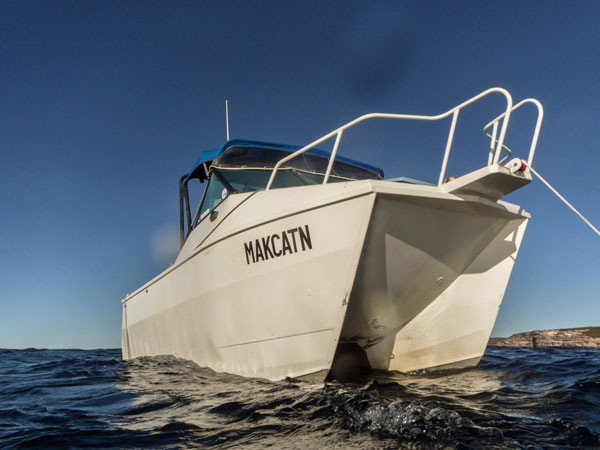 |  |
MakCat anchored at Barrens Hut on a dive
Photo by Michael Roelens | MakCat coming back into Port Hacking after a dive
Photo by Aidan Slevin |
Tanks are kept on the sides of the boat, strapped to inside of gunnel the using weight belts. I also put a large swimming pool noodle along the lip of the pocket inside the hulls to protect the paint from being scratched. However I later removed it as it pushed the bottom of our dive tanks out too far and they were not standing vertically. I replaced it with a simple rubber protection strip.
There is space for three tanks on each side (they will hold twins or a tank and pony for our deeper dives). The rear starboard one holds our oxygen cylinder when we are deep diving. See later for safety features. Weight belts are stored in two small plastic bins in front of the seats under the false floors I had installed.
It has a "roll-over bar" which not only holds the GPS aerial, it holds the VHF and AIS aerials and dive flag (in a fishing rod holder). This bar is a hand hold while travelling along. The normal anchor is kept in the chain locker and the reef anchor (for wreck diving) is stored in the forward cabin.
The boat has twin motors which means it has a walk-through transom, perfect for divers. There is a ladder attached here and this is designed so that you can exit the water with your fins on. See the attached photographs for more details. You enter the water by a backward roll or a giant stride through the transom.
OLD ENGINES
When purchased MakCat had two 2003 Mercury 75hp 4 stroke (model 75ELPT S4) engines. These were actually made by Yamaha and are almost identical to the Yamaha 75 hp 4 stroke engines, but there are some very small, but important, differences. See later for at least one of these. These were purchased independently by the previous owner (to replace 2 stokes) but he said they had about 330 hours on them when I got the boat in early 2016. The props were stainless steel 16 inch pitch. I thought I may need to change to the 18 inch ones from Le Scat but it seems to have the right amount of torque and top end speed so I did not change.
The Mercury 75 hp 4 stroke engines have four cylinders and displace 1,523 cc. They weigh about 177 kg each (compared to 138 kg for 2 stroke) and not 162 kg as claimed in some specifications and have 4 carburettors. Maximum revs is 5,750 rpm with the props we have installed (16 inch). They have a very nice sound to them!
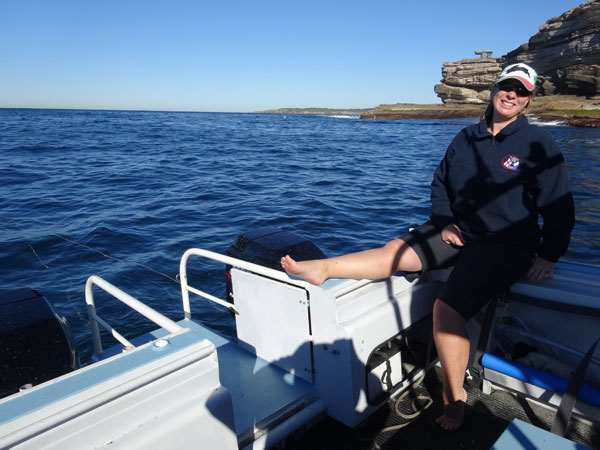 | 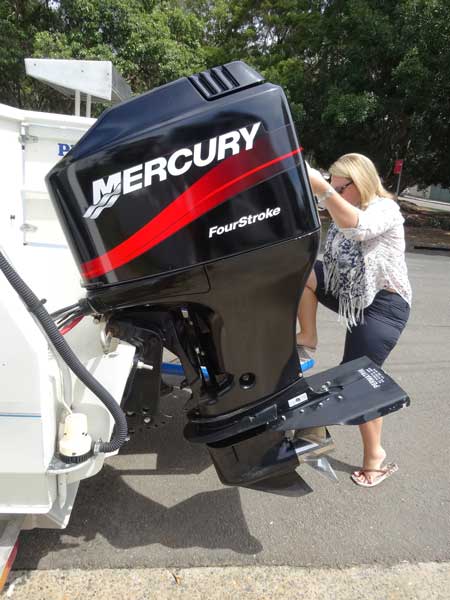 |
| Kelly at the rear of the boat on MakCat's first dive | The port engine of MakCat |
On 24 April 2016 I took MakCat out for her first run. I only had one other person on board nor any load. Launching was a bit of a problem as the ramp we used was at a very low tide and it does not have a great gradient, especially at low. I had to back up and stop hard many times before it would come off the trailer. I realised I would need to grease the rollers and runners so it goes on and off a lot easier (this was also a problem on the old boat till we did this). On the first two dives the greasing worked perfectly, it goes on and off much better.
Once in the water I took her for a run up the Georges River. The boat planed at about 3,000 rpm and at 4,000 rpm we were doing 20 knots. This is the same speed as Le Scat did at 4,750 rpm (but with a near full load). We also realised we needed to remove the live bait setup as once we took off, water poured out of the hose, as it is powered by the forward movement of the boat (it has since been removed).
When I finally took her out diving (with four on board), we did 22 knots at 4,400 rpm and 28 knots at 5,000 rpm. Later we did 33 knots at 5,750 rpm, almost 61 km/h, again with four and dive gear on board. Sure flies! Even with five on board, it did 20 knots at 4,200 rpm.
It seems to me that it is best (economy and handling) at 4,400 rpm. My old boat required the engines to be tilted up till they cavitated and then dropped back till it stopped. This gave the best ride. Originally, on this boat doing that put the bow too high in the air. Accordingly, I needed to tilt the motors up only a little bit to get the best out of both the engines and the boat. I ended up removing the trim tabs from the engines which made it far less "twitchy" when adjusting the trim. Since I moved a lot of weight forward (see later), I trim the motors as per the old boat.
One thing that concerned me about these engines is that when you put them into neutral after running at speed, there is a whining noise from both engines. It is not there when you first start the engines, and it is not always there. I did some internet searching and found that this appears to be a common situation with Mercury four strokes of this age and similar size. It appears to be caused by the driveshaft vibrating and only occurs after running at speed. I read that it can be stopped by putting the engines back in gear and then back into neutral. I can confirm that this works.
Another problem is that when the engines are first started, sometimes an alarm went off. Again, this appears to be common. It is the oil pressure alarm but stopping and starting the engine makes it go away (seems to only occur on cold mornings when oil is probably thick).
See below for new Yamaha engines.
FUEL ECONOMY
Now that I have done a lot of hours it is possible to work out the fuel economy pretty accurately. The tanks are said to be 100 litres each (according to specifications I have found on the net) and they appear to be located under the floor aft of the filler. I am not aware of the actual dimensions, so this does not make it easy for me to measure the fuel level unless the boat is on level ground. I use some thin long dowels down the fuel filler and have marked them off in 5% increments. It seems that the 100 litre size is probably correct as adding 20 litres to a tank takes it up about 20%.
As of April 2021 and 282 hours, the engines use a constant 17.3 litres per hour (8.65 l/hr each). This is at about 4,600 rpm. This about half the fuel used by the engines on Le Scat.
The boat has two fuel tanks (which feed an engine each) giving a total of 200 litres of fuel. I normally keep the fuel between 1/3 and 1/2 at the start of a dive. There is no point in carrying around extra weight unless you need to. This is more than sufficient for even the longest run in Sydney with a large reserve. I figure that a full tank will get us about 14 hours run time, that is, about 285 nm or 527 kilometres!
DIVER CAPACITY
My old boat (Le Scat) used to easily carry six divers and gear (five on deep dives). However, as MakCat has less deck space and is much heavier in the stern due to the heavier four stroke motors, I know that I cannot carry six divers. For the first six runs I carried four divers and this was very comfortable.
After I moved the batteries (and some other weight) forward, I decided to take out five divers to see how that went. On 22 June I dived with five on board. This was comfortable and we were no more stern heavy than with four. I will take five divers from now on if there are that many who want to go. I only take four on deep dives as we have more tanks and gear. There is space for six tanks. When away diving at Jervis Bay in February 2018 and doing double dives, I only took four on the boat.
HANDLING
Like most cats, in simple terms, generally extremely good. The boat planes when full at under 3,500 rpm and appears to be best at 4,400 to 4.600 rpm. At this engine speed it is doing about 40 km/h (21 to 23 knots). Running across flat water and tilting the engines up slightly (only a touch) lifts the nose and cuts spray. However, when running with a strong wind on the beam, the spray can come over the sides and wet us.
Once on the open ocean, it takes slight chop with no reduction in speed. Even in a fair bit of chop I can proceed at normal speed. This may entail a bit of leaping almost clear of the water but the cushioning effect of the twin hulls keeps it comfortable. In very big seas I can keep going where single hull boats have to turn around. There have been many times when I have been able to dive a site that single hulls could not reach.
 |  |
| MakCat at the boat ramp | Putting MakCat back on the trailer |
Like all cats, it can be a bit difficult to handle when the sea is from the behind quarters. In such cases, the boat wants to breach (it won't, but it moves around a bit). I have discovered that using slightly more throttle on the motor on the same side as the direction the swell is coming from almost stops this tendency. I think that this boat is a bit better compared to Le Scat as it is not as twitchy.
One problem I identified early one was that when you suddenly pulled power off, water came into the boat over the transom. However, once I moved the weight forward, this seems to have basically gone away, although I do not pull off the power very quickly. I can still get some water in when at rest if we have too many at the stern or if we have seas coming from astern. I also put a blocker under the transom door to limit water ingress.
When anchored, the twin hulls make it quite stable for gearing up etc.
ANCHORS
For reef diving I use a large 15 lb sand plough with about 10 metres of heavy chain. There are 100 metres of 10 mm rope attached. I do not use a reef anchor for reefs as I do not want the boat coming free when we are diving. At the start of a dive, the first divers secure it and the last divers to leave the bottom place it at the end of their dive in a position where it can be easily retrieved. For wreck dives I use a large reef anchor (as the sand plough would grab in the sand that surrounds most Sydney wrecks). This has lead in its body to make it sink quicker.
When the anchor is on a deep wreck, we use a buoy to lift it to the surface. This is done by attaching the buoy to the anchor rope once we are ready to haul the anchor in and then running the boat forward. The buoy runs down the anchor line and lifts the anchor to the surface. Contact me for a more detailed explanation.
When the anchor is in water any deeper than about 15 metres, we attach a cross-over line to it. This is a lead weight which is looped over the anchor and dropped. The other end of the line (about 30 metres), is attached to the bottom of the deco weight line. This deco line goes from the back right corner of the boat to about 12 metres. The cross-over line serves a few purposes.
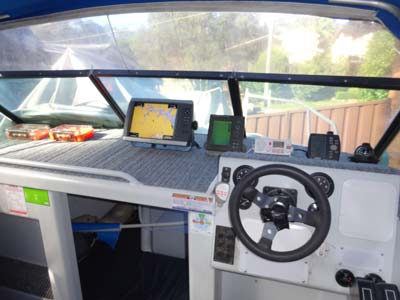 | 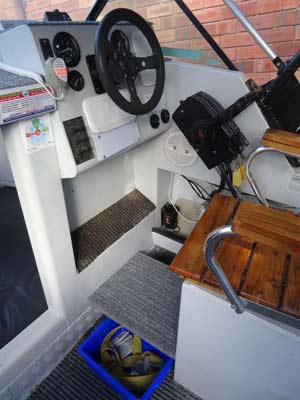 |
| The dash showing the new carpet | The new false floor after I carpeted
it showing the new weight bin underneath |
First, it enables divers to go straight down the deco line rather than swim on the surface to the anchor (especially good in heavy seas or currents). Once at the bottom of the deco line you simply follow the cross-over to the anchor. Secondly, the weight on the anchor end lays the anchor down more horizontally, thus increasing the effectiveness of the anchor and lessening the chances of it coming loose. Thirdly, by following it back to the boat, you slow yourself down on ascent from the 30 metre to 12 metre mark. Finally, in dirty water, it enables you to easily swim back to the deco line.
SAFETY FEATURES - Including safe diving practices
The boat is equipped with VHF radio, EPIRB, chartplotter, depth sounder, GPS, AIS, oxygen kit, First Aid kit and lifejackets. I carry mobile phones, a lot of drinking water as well as sun cream. There is a set of jumper leads in case one battery is dead. I became a licensed Commercial Coxswain in 1991. Kelly has been a licensed boat driver for over 20 years and also worked at NSW Maritime a couple of times and holds SES boat certificates. I am a volunteer member of NSW Marine Rescue. I always log on with Marine Rescue when we go out, using a phone app that gives them the location every 30 minutes. The AIS transmits the position every few minutes.
I hold a Senior First Aid certificate as do many others who use the boat. I also have an oxygen therapy kit on board.
Specific items carried relating to diving are oxygen cylinder with long hose to enable oxygen to be breathed on decompression stops after deep dives, mermaid line for use in currents, dive flag and extra weights for underweighted divers. The deco line (see previous items) is also a great safety feature, enabling divers to deco while holding a line that is not as subject to movement as an anchor, the cross-over line enabling divers to avoid swimming on the surface before a dive. I also have diving spare parts (like fin and mask straps, spare regs and even an extra dive computer).
 |  |
| The rear deck ready to dive | Another shot cockpit showing all the work I did |
The people who use the boat are generally very experienced. I have done well over 4,000 dives (see My Dive Info Page for more information) and Kelly almost 2,000 dives. The average number of dives completed by the people who regularly dive with us would be over 1,000 dives. Since most people on the boat have already dived the locations we visit, dive briefings are not normally given. However, I give full and complete briefings to people who have never visited the site we are diving and in most cases, one of the people who are very familiar with the site will accompany them.
When diving, we always have people either in the boat or under it. The boat is never left unattended in case the anchor breaks or comes free. On deep dives, we dive in pairs. The last two can enter the water before the others have surfaced or indeed, returned to the boat. However, they must not leave the anchor unless they have seen the first two divers ascending and received an okay signal from them. On shallower dives, we set a time limit for the first two divers. They do not have to ascend, but have to be back at the anchor or under the boat within sight of the deco line by this time. If the last two divers do not see the first two and get an okay, then they cannot move away from the boat. This has worked satisfactorily since I implemented it in late 1993. We often do drift dives in which half the divers enter the water and the remaining follow in the boat. This process is repeated once the first divers have finished their dive.
When deep diving (over 35 metres), I insist on divers having a back up air supply. In most cases this is a pony bottle. Some use twin tanks. I will not take anyone, no matter their professed level of training or experience, on a deep dive unless they have convinced us that they are competent. This convincing is only achieved by diving in normal circumstances with us and then I make a decision as to whether I will take them deep. Quite a few times I have declined to take an allegedly trained and experienced diver on a deep dive till I saw them in action.
COMFORT FEATURES
The boat has a dry area at the bow. I carry a number of plastic bins here in which we put all clothes. After a dive we normally change out of our wetsuits into dry clothes, especially in Winter. We also store our food and drinks for morning tea here.
 |  |
| MakCat at the Yowie Bay boat ramp wharf | Having morning tea at Jibbon after a dive
Michael Roelens at left and Les Caterson right |
I have a system for a warm shower after a dive (to wash salt off and to warm up). This was a pressure pump that sucked water out of a container and through a pet shower head but it is not working great. I have reverted to my old system of a watering can head on a water container. Nice! There is also canopy over the cabin area and we can erect a cover over the rest of the boat on hot or wet days.
I even have two Apollo underwater scooters that divers on the boat can use!
TRAILER
MakCat is carried on a dual axle aluminium trailer. It has mechanical brakes. It has skids rather than rollers. It came with an electric winch to pull the boat back on the trailer if needed. Normally we drive it on but the boat ramp at the yacht club does not permit this, so the winch would have been very handy. However, when tested in early 2018, it did not have enough grunt to pull the boat onto the trailer. I decided to look at an alternative winch later (See below).
TOWING
The all up weight of the boat and trailer, with half a tank of fuel, is about 1,650 kilograms (I think - based on claimed towing weight with 2 strokes of 1,450 kg). It is certainly much less than my old Marlin Broadbill as it was easier to tow up out of my street with my old Toyota Land Cruiser Prado (V6 3.4 litre petrol engine). In November 2017 I upgraded to a Toyota Land Cruiser Sahara 200 series.
The Prado was capable of towing okay but on some hilly locations where I had to stop for a red light, it was hard to get restarted. From the main place where I launch the boat (Yowie Bay boat ramp), while I could use high range, it was better to use low range till I got up onto the flat section of road. Fuel consumption was about 17.5 litres per 100 kilometres when towing (compared to 14.5 around town and 12.5 in country). Maximum speed that I felt safe towing such a big boat was 80 kilometres per hour.
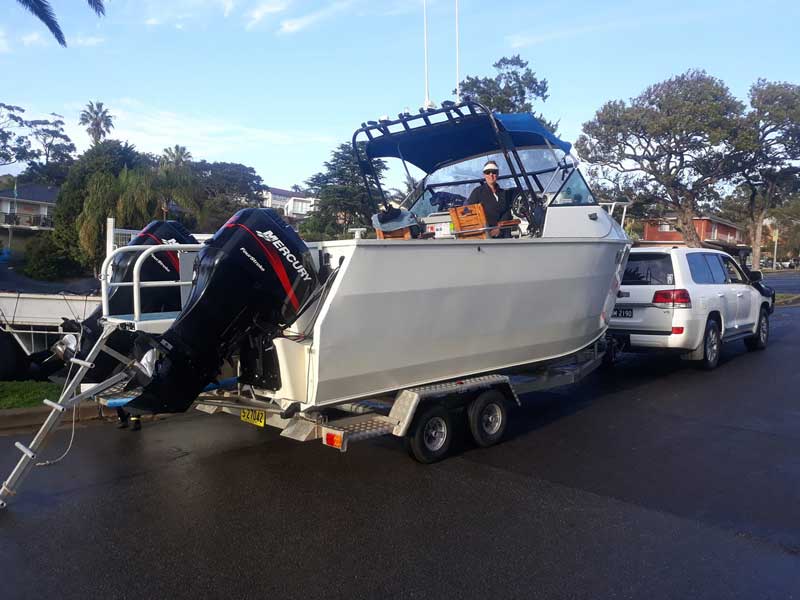 |
| MakCat at the Yowie Bay boat ramp behind my LandCruiser. |
The Sahara 200 series is a totally different thing. It pulls the boat like it was not even behind. I use high range to pull up the driveway, up my street and also out of the water at the boat ramps. We can even accelerate up these hills!. I have not had the Sahara long, but the fuel consumption with combined driving and towing around town is about 17 to 18 litres per 100 kilometres, so about the same as the Prado. In February 2018 I towed it down to Jervis Bay and back. The fuel economy for this whole trip, down, running back and forth to the ramp and then back home was 17.5 l/100km. This was amazing, as I sat on 100 km/h on the freeway and the speed limit elsewhere. It even included coming back up Mount Ousley at the speed limit of 80 km/h rather than the 30 to 40 when using the Prado.
COST
The cost of the boat and modifications etc was as follows:
| Item | Cost | I sold some items from old boat and this one | Item | Sale Price |
| Purchase | $38,000 | | Engines | $4,000 |
| Welding, pumps | $1,100 | | Trolling arms | $325 |
| Boat Cover | $190 | | Seats | $50 | | |
| EPIRB | $240 | | Fuel tanks | $100 |
| Towball lock | $50 | | Ladder | $51 |
| Flares | $65 | | Burley bucket | $30 |
| Various items | | | Bow roller | $15 |
| Deck Paint | $44 | | Hull aluminium | $560 | |
| Pipe for cover | $ | | Old trailer | $800 | |
| Spare wheel carrier | $40 | | Ebay fee | -$199 |
| Bollards (x2) | $34 | | Foam/cabin dumping | -$58 |
| Waterproof containers (x2) | $40 | | |
| Small Bins (x2) and large bucket | $20 | | |
| Goof Off (glue remover) | $51 | | |
| Insurance | $602 | | |
| Trailer rego transfer | $47 | | |
| Boat rego transfer | $30 | | |
| Boat rego (personalised) | $176 | | |
| Boat labels | $11 | | |
| Gloveboxes | $83 | | |
| New carpet and glue | $103 | | |
| Trailer repairs | $2,885 | | |
| Insurance | $602 | | |
| Signs | $10 | | |
| Battery wire | $121 | | |
| TOTAL: | $43,637 | | TOTAL: | $5,684 |
| FINAL COST: | $37,953 | | |
I installed AIS in November/December 2017 at a total cost of about $410 including a second aerial. It is a Matsutec HA-102 CLASS B AIS Transponder which I got from Ebay for AU$360 delivered. The instructions were poor, but I worked it out and linked it into the chartplotter. I had to buy an additional aerial and also use a GPS aerial I had. This seems to work well. Certainly cheaper than other AIS options.
In early 2018 I also had some welding done to repair broken mounts for a grab rail along the port side. At the same time I had some extra mounts installed on both sides. I then repainted the gunwales, the bin and walk-though and also repainted the whole of the interior.
Due to on-going problems with battery power, in May 2018 I put in a third battery which is now dedicated to running the instruments. This is because the Garmin chartplotter uses a huge amount of power. In the end I had to buy a new battery to replace the old ex-engine one I used. Even then, I have to recharge the third battery every third or fourth dive as the Garmin uses so much power that even when running, the engine cannot top it back up.
I cannot really remember what the steering was like when I purchased the boat, but over time it got a lot harder to turn. In addition, when I came back from six months sailing in November 2018 I could not turn the steering wheel at all. I eventually freed it up but after that it was very hard to turn to port. I worked out what the problem was but was not able to fix it myself, In August 2018 when I had the engines serviced, I got the mechanic to look at the steering. He ended up having as much trouble as I did and broke the hydraulic ram trying to extricate it from the engine tilt hole.
In the end I ended up with a new hydraulic system (using existing steering assembly and hoses) and the mechanic reamed out the engine tilt hole. Now it works so well I can steer using one finger!!!
When I first tested the boat, we got no water in the hulls at all. However, once I started using for diving, we would get perhaps 30 litres in each hull. No matter how hard I looked, I could not find any obvious spot where it was getting it. The funny thing was, when I had the trailer upgraded, I put the boat in the water for about 10 hours and there was no water in it at all. This made me think it was coming in under pressure, that is, a very small hole or crack.
Finally at the end of September 2018 I discovered a few very fine cracks in some welds at the front of the boat. Putting silicon on them over a few trips let me discover all of them. There was also one hole towards the back of the starboard hull. This was still mostly covered with corroded aluminium but would let water in. I then covered all these with Sikaflex.
By the end of 2018 I was certain I had all the leaks worked out. In early February 2019 I had the cracks and hole welded (some were probably not cracks, but I welded them anyway). After then, no water at all came in via the hulls, the only water is from dive gear after a dive and also some that comes through the open transom at times.
However, in late 2020 I again started to get a lot of water in. It was very hard to find where this was coming in, in fact it was not till I completely filled each hull with water in April 2021 that I found them. There were a few very small holes in welds on the chine on the starboard hull and a large one on a weld on the port hull that was repaired in 2019. There were also a few other suspect spots that I was not sure of as well as some spots where old depth sounders had been removed. In addition, there was also a series of holes on the centre hull section right at the stern. I had all these fixed and again there is little water getting in. The welds especially appear to be a problem.
In September 2019 I purchased a 4WD winch from Kings Superstore. This is a 12,000 lb one with synthetic cable. I removed the old power winch (which was really a starter motor) and installed the new one. I needed to modify a few minor things and also change the cable ends to an Anderson plug to connect into the cable I already installed in the LandCruiser. The cost of the winch was $349 delivered and the extras I needed probably $80.
 |
| MakCat's new winch |
On 21 September 2019 I tried the winch for the first time at a boat ramp called "Hole in the Wall". This is a problematic ramp for me as at lower tides we have hit bottom lots of times when trying to put the boat back on the trailer. On this day, I had the trailer in the water as normal (the ramp is a shallower incline than most ramps) and my friend nudged the hulls just onto the bottom skid of the trailer. Another friend hooked the winch rope onto the boat and then I winched her in. Well, it came up and onto the trailer quicker and easier than expected. A total success! Since then, it has continued to work brilliantly. I only use it at certain ramps which are shallow or driving onto the trailer is not permitted.
ENGINE FAILURE
In August 2020 I started having some problems with the port engine. In the end, I had to call my mechanic to have a look. It even baffled him for a while. What it turned out to be was a switch that cuts the revs when you pulled the throttle back to neutral. It is supposed to cut revs dramatically and then go back to normal. Turns out the switch had failed and was staying on despite what should have happened. It eventually came good after 3 to 5 minutes. Replacing the switch fixed the problem. Note that this switch is not on the identical Yamaha engine.
As soon as this was fixed, the starboard engine had problems. At first I thought it was a fuel filter problem (the filters had prematurely rusted and let water in) but this was not the case. Over three days use I constantly had problems with the engine not revving out as it should. After the last day, I checked the oil and found that it was milky, indicating there was water in it.
I took out the spark plugs and found moisture on the top two. I called my mechanic and he indicated that the likely problem was corrosion between the water cooling canals (my words) and the combustion chamber. He had me squirt WD-40 in the cylinders as I turned it over. This was because the COVID-19 pandemic meant that every man and his dog with an old boat in bad condition was wanting it to be fixed and he would not be able to get to it for a long while.
As it turned out, it took 6.5 weeks to get in into the service centre and another 5.5 weeks to repair. Turns out he was correct, the head needed welding and machining. In the end, the repair cost was under $1,500, much less than I expected. Since then it has run perfectly, even better than before.
NEW ENGINE PROBLEM
In late 2022 the starboard engine started playing up and making strange sounds. In late January 2023 I finally had my mechanic look at it (he was on holidays before this). He advised that the problem was the bearings on the bottom cylinder. It took a while to find someone who could fix the engine and finally the mechanic found someone for me. I took the boat there and he tested the engine and pulled it apart.
Unfortunately, he had a few problems and broke a section when trying to get the engine off the boat. Then, he had to use an angle grinder to get the sections of the engine apart. So, what turned out to be a medium problem became a much bigger problem. After he pulled it all apart, he advised that the cost to repair would be $10,000 as he needed to source many parts from the USA as well as get the sections of the engine he had to break or broke. This also included a full service on the engine.
It ended up taking a long time to get the parts and finally in May it was ready to go back on the boat. However, I was going away for three weeks. Then, when I came back and took the boat there, he had hurt his back. Finally I got the boat back in late June 2023. I also had him do a major service on the other engine and replace a couple of bits that he had not quoted on. Total cost was $12,000!
While the cost of a new engine would not have been a great deal more than the repair cost, I would have had to purchase two engines. Hopefully the repair will give me an engine that will last a long time.
NEW ENGINES
Well, so much for my comments in the last paragraph. In late 2023 there was another problem, this time with the port engine. It turns out it was the same problem that the starboard engine had back in 2020, water getting into the cylinders. What to do? Is it worth repairing this engine and then having more problems with it or the other engine? If we get new engines, will we get the value out of them considering my age (66).
 | 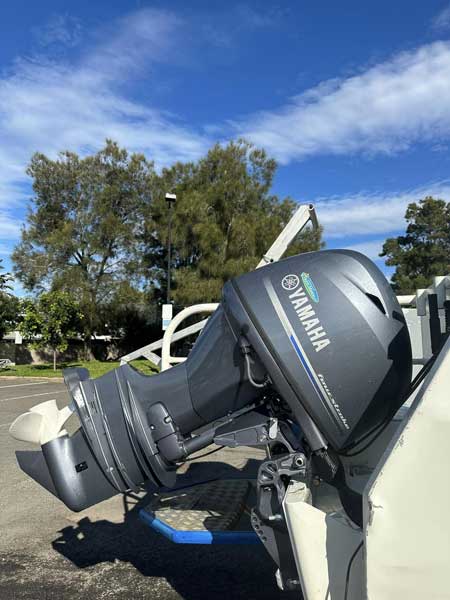 |
| MakCat at Hunts Marine with the new engines | A close up of the engines |
After a lot of thought, Kelly (she still owns half the boat despite us divorcing in 2019) and I decided to buy new engines. In late June 2024 MakCat was back in the water with two new Yamaha F70XA (extra long shaft) four strokes. We decided to go with these instead of 75 hp engines as the Yamaha 70hp are each 45 kilograms lighter (121kg v 166kg). This means the engines are about the weight of a person less than the old ones or alternate ones. This applies to the difference between the 70hp and all the other brand 75hp engines.
As we have always had a lot of problems with too much weight at the stern, I figured that this will fix that problem and despite being 10 hp down and a fair bit of torque as they are 996cc compared to 1832cc for the 75 hp. The F70 engines are four cylinder like the F75 but the F70 has four valves per cylinder rather than two. The new engines are of course fuel injected rather than carburettor. The old engines pushed the boat at 33 knots flat out which I never needed. As long as I can sit on 22 knots or so at a good rpm with the ability to get to high 20s, then it will be all good.
On 29 June 2024 we took it for a run with a couple of friends on board for some "ballast". We ended up doing 1.7 engine hours and ran across Botany Bay to the ocean and did some whale watching (saw at least 10 humpback whales). First impression is that the stern is now too light, as the 90 kg weight saving has made it more like it would have been when it had 2 stoke engines (before we owned it). Since I had moved the batteries to the bow, this has made the stern perhaps too light,
 | 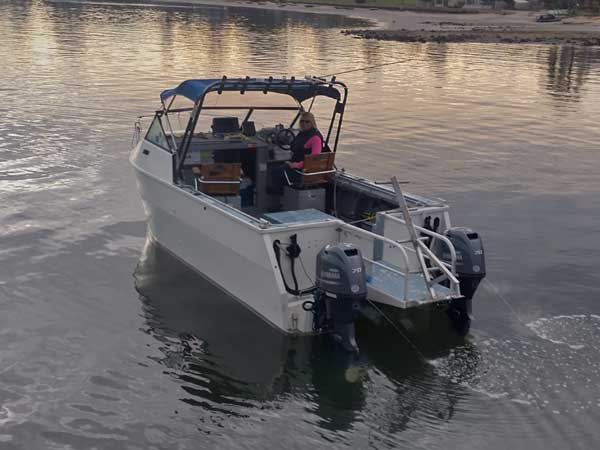 |
| Launching MakCat at Hole in the Wall ramp | Off the wharf, note how high the stern is above water |
To counteract this I moved the dive weights and deco weight to the stern. This added about 30 kgs there (I have some spare weights there as well). I will also put two tanks in the rear spots instead of one normally put there (if I have five on board). This has made it a bit heavier at the stern and the boat now performs much better than the first runs.
Anyway, with only four on board and no gear, we easily did 21 knots at 4700 rpm. I hit over 26 knots but that was not flat out. The new engines have a fuel consumption gauge (at that times they were only reading one engine but my reading of the manual was that it should read both - later it was fixed). It showed we were roughly using 13 litres per hour. It also showed consumption of between 1.4 and 1.6 nautical miles per litre depending on rpm (see later corrections). This will obviously need a lot of time to work out the best rpm etc.
For this day, the engines showed use of 14.8 litres for each engine which once I checked the tanks was accurate.
The next day we took MakCat out again. This time we were diving. It was a pretty average day, raining a lot before sunrise, but it stopped about 6 am and did not rain again till we were back at the boat ramp. We had four divers on board so we moved all the weights to the stern to try to counteract the lightness there. We also put two of the tanks in the rearmost spot.
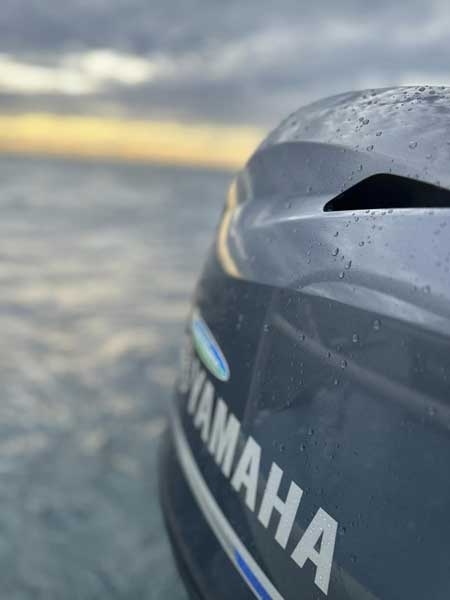 |  |
| An artistic photo of the starboard engine | Retrieving MakCat at Hole in the Wall |
The boat performed more than adequately with the extra weight. I think we were doing about one knot less than the old engines at the same rpm. No problems! As we have to run the engines in to a certain extent, it meant varying the rpm a far bit. The best performance in terms of speed and fuel consumption appears to be around 4700 rpm.
At the dive site there was no water at all near the transom and when getting back on the boat, it was noticeable that the ladder was higher out of the water and the stern section well out of the water. All in all, very satisfied so far.
10 July 2024 was the next suitable day weatherwise so I did a mid-week boat dive with four other members of St George Scuba Club. The run out was just as good as the previous time. The only thing I noticed was that when I started up from stopped with the engines tilted up for running, it was a little slower taking off. Despite this, it was more than adequate.
With five on board and all dive gear, we sat on 20 knots or so at 4500rpm and 22 knots at 4800rpm. The stated economy at both these speeds was 0.65 nautical mile per litre (two engines). In reality, it was about 1.4 or 1.5 nm/l for one engine on the gauge (note, the gauge now shows consumption for both engines). So, 0.7 to 0.75 nm/l.
Each engine was using about 13 litres per hour at 4500rpm and 15 l/hr at 4800rpm (26 to 30 l/hr for two engines). I am more than happy with this. I have also run for a very short distance at 6000rpm and we were doing over 27 knots. This is as per the documentation for an almost identical boat to mine on the Yamaha website. Again, once anchored, the stern was not low in the water like it used to be, so all is good there.
As of 8 October 2025 I have taken it out 52 times for diving (55.7 hours). I am averaging around 20.2 litres per hour. At 4700 rpm, the fuel consumption is about 0.7 nautical mile per litre (30 litres per hour). This is a bit worse than the figure given in the brochure for an almost identical Sailfish boat which was shown as 0.89 nm/litre at 4500 rpm and 0.81 nm/l at 5000 rpm. Those figures were with a boat only loaded with three people. As I normally carry five with full dive gear, I think that this is probably better than the stated figures. Note: I do not use the boat for anything but scuba diving, so I never run with a light load.
In May 2025 the starboard tilt was replaced under warranty as it was constantly (but slowly) dropping the engine. Even when stopped for an hour, it dropped significantly. Apparently this is a known problem and the dealer replaced without any questions.
Also, when the gauges were originally cabled, the fuel consumption was only coming from one engine rather than both as it was supposed to. I tried to fix, but the cabling was incorrect. In May 2025 the dealer corrected this so now the gauge shows fuel consumption from both engines combined.
However, in September 2025 I realised that now the figures showing on the port engine tachometer were coming from the starboard engine. This included revs, voltage, hours and engine tilt. I then checked the setup and thought that I discovered they had removed one of the two buses (where the cables connect from engine and then to the gauges). The Yamaha diagram for two engine setups shows a totally different setup to what I appeared to have.
In early October the service manager visited me at home and had a look at it. He agreed that the tachometers are not working correctly. However, it seems that they moved one of the buses from under the front where the other is still and moved it to the rear above the fuel filter. It is correctly wired. After a lot of thinking about it and a few attempts by changing the cables, he remembered that you have to nominate the engines/tachos (not sure which) as 1 and 2. Appears that both were nominated as 1, hence all data was only coming from the starboard engine. It nows works perfectly and I confirmed this the next day when I went diving. Phew!!
NEW CANOPY
When I bought MakCat back in 2016 the canopy was not in the best of conditions and I had to do some repairs to it soon after purchase. The main one was that the front frame member was broken in the middle, making the canopy be at a funny angle. When I pulled it apart I found that the aluminium section was broken in the middle (well the joint was). I tried to find a smaller diameter aluminium tube to put inside to fix, but I had no luck. Instead I repaired with a piece of timber dowel and this worked for a long time till it broke about 2022.
After about three or four years the stitching along most of the seams basically failed, so I pulled the whole thing apart and using my sowing machine, I resewed the failed pieces and all the other bits. Again, this lasted well, even in 2025 most of it was still okay.
However, by 2024 the canvas fabric was wearing in many spots, with large holes forming. In addition, the by now the canvas hung loose and the waterproofing failed and rain would seep through. Although I did waterproof it successfully, the pools that built up inevitably fell over us. In late 2024 I decided to replace the canopy but all the companies I contacted had long waiting times.
In March 2025 the canopy was finally replaced. All new frames were made. I also decided to put clears on both sides where previously there had been nothing. This cost $2,750 all up. Keeps us much drier in windy conditions.
 |  |
| New MakCat canopy from rear, note the new clears at left | New canopy from the front |
SUMMARY
All in all, I know that Le Scat was the best set up private dive boat in NSW. MakCat is not as good a boat, but it is still one of the best set up private dive boats in NSW. It is even better set up than most charter boats I have been on. The big advantages of using my own boat is that we have everything on board we need, we know where it is (as do most of the friends who dive with me) and we dive where we want to. We also dive places that charter boats rarely or never visit.
Hopefully I will get as great service out of MakCat as I did Le Scat, although I doubt I will still be diving in 23 years!
Diving is meant to be fun, it is on my boat.
| 
 v6.00.307 © 2003-2005
v6.00.307 © 2003-2005